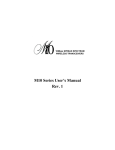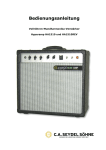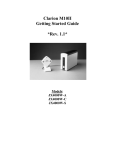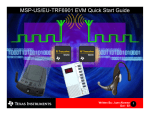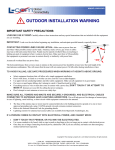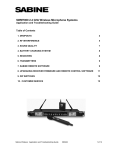Download Clarion M10II Installation manual
Transcript
Clarion/Hyperlink Bridge Kit Installation Manual Rev. A Page 1 Hyperlink/Clarion M10II Extended Range Wireless LAN Bridge Kit Featuring the Clarion M10II 10 Mbit/sec Wireless Bridge Installation Manual Quick Installation Manual –Page 18 Copyright © 1996, Clarion Corporation of America. All rights reserved. No part of the contents of this document may be transmitted or reproduced in any form or by any means without the written permission of Clarion Corporation of America. Portions Copyright © 1998, Hyperlink Technologies, Inc. All rights reserved HyperGain and HyperAmp are trademarks of Hyperlink Technologies, Inc. Hyperlink Technologies, Inc. Clarion/Hyperlink Bridge Kit Installation Manual Rev. A Page 3 Contents FCC Radio Interference Statement Introduction Features of the JX4000 Types of Installations System Requirements Kit Contents Tools Required M10II Front & Rear Panel Features Connections & Features of the Amplified Antenna The DC Power Injector/Lightning Protector Overall System Configuration Antenna System Connections Surveying the Antenna Site Preparing for System Installation Mounting & Cabling the Amplified Antenna System Basic System Checks Amplifier & DC Power Injector LEDs M10II LED Diagnostic Displays Clarion M10II Specifications Quick Installation Manual APPENDICES Antenna Mounting Instructions Hyperlink Technologies, Inc. 4 5 5 6 7 7 7 8 9 10 11 12 12 13 13 15 15 16 17 18 Appendix A Clarion/Hyperlink Bridge Kit Installation Manual Rev. A Page 4 WARNINGS The manufacturer assumes no responsibility for damage caused by interference due to this equipment. Radio Frequency Interference Statement USA - Federal Communications Commission (FCC): This device complies with Part 15 of FCC Rules. Operation of this device is subject to the following two conditions: This device may not cause harmful interference. This device must accept any interference that may cause undesired operation. Information to User: This device must be installed and used in strict accordance with the manufacturer's instructions. However, there is no guarantee that interference to radio communications will not occur in a particular commercial installation. If this device does cause interference, which can be determined by turning the host equipment off and on, the user is encouraged to consult the instruction manual of the host equipment or the local device supplier. In case the device does cause harmful interference with an authorized radio service, the user/operator shall promptly stop operating the device until harmful interference has been eliminated. The manufacturer is not responsible for any radio or television interference caused by unauthorized modification of this device or the substitution or attachment of connecting cables and equipment other than those supplied. The correction of interference caused by such unauthorized modification, substitution or attachment will be the responsibility of the user. Hyperlink Technologies, Inc. Clarion/Hyperlink Bridge Kit Installation Manual Rev. A Page 5 Introduction The Clarion M10II is a wireless transceiver providing 10 Mbit/sec burst data rate to support wireless connections in IEEE 802.3 and Ethernet II (TCP/IP) LAN. Equipped with a Hyperlink Extended Range Amplified Antenna System, the M10II offers an ultra high-performance long-range building-to-building network bridge. The M10II functions as an Ethernet MAU. It uses a state-of-the-art spread spectrum technology to implement robust 10 Mbps burst transmission. It also actualizes efficient utilization of frame buffers and coordination of RF and wired interface traffic to maintain high throughput. The M10II offers true “Plug and Play” installation. No additional driver software is required for operation. That is, the M10II can be connected not only to a computer but also to a hub or to a router. FEATURES OF THE M10II The Clarion M10II has the following features: • Full wireless Ethernet 10 Mbps data rate. • State-of-the-art spread spectrum technology provides reliable, secure, long range, radio link operation. • True “Plug and Play” installation for compatibility with all 802.3 and Ethernet II LAN devices, all operating systems and all protocol stacks. Hyperlink Technologies, Inc. Clarion/Hyperlink Bridge Kit Installation Manual Rev. A Page 6 Types of Installations The type of application will determine which type of kit to install: Building-to-Building or Tower-to-Tower: Typically these installations will typically require directional Yagi or Grid Antenna kits. Central Node in a Multipoint Network or Mobile Network: This type of installation typically requires an Omni Directional Kit at the central node for 360 degree coverage. System Requirements The Clarion/HyperGain™ Amplified Extended Range Bridge Kit provides a Hyperlink Technologies, Inc. Clarion/Hyperlink Bridge Kit Installation Manual Rev. A Page 7 complete plug-and-play solution for linking buildings in an outdoor environment. All you need to add is suitable masts or towers and some basic site planning. Please read this manual in its entirety before beginning the installation. Kit Contents: Each Kit contains the following items: Clarion M10II Radio and DC Power Supply HyperAmp Remote Mounted Amplifier HyperGain Antenna (Omni, Yagi, or Grid) HyperGain DC Power Injector/Lightning Protector Signal Filter 50 ft. Antenna Cable 4 ft. Jumper Cable Mounting Hardware Sealant Tape Manual Tools Required: 7/16" open-end wrench or Adjustable Wrench #12-10 AWG or similar wire (for grounding) Wire Cutter / Stripper Pliers Other Required Equipment: Suitable mast or tower hardware Transceiver Other Helpful Equipment and Tools: Cellular telephones or Walkie-talkies Binoculars Compass Handheld GPS Hyperlink Technologies, Inc. Clarion/Hyperlink Bridge Kit Installation Manual Rev. A Page 8 M10II Front and Rear Panel Features Internal antenna (inside of the top cover) MAU port MAU LED TX LED External antenna port RX LED Power LED DC 6.2V port Power Switch FCC Certification label (bottom) Hyperlink Technologies, Inc. Clarion/Hyperlink Bridge Kit Installation Manual Rev. A Page 9 Connections and Features of the Amplified Antenna Familiarize yourself with the connections and features of the Amplifier Unit: Mounting Flanges: Two sets of mounting holes are provided on the amplifier’s mounting flanges for either mast mounting using the included U-bolts, or bolted directly to a bracket or other structure. Power/Transmit Indicator LED: This LED glows green in receive mode when power is applied to the amplifier, and it flashes a red/orange color when transmitting. Radio Connection: This connection attaches to the DC Power Injector via the antenna feed cable, and provides both signal and DC coupled power. Hyperlink Technologies, Inc. Clarion/Hyperlink Bridge Kit Installation Manual Rev. A Page 10 The DC Power Injector/ Lightning Protector The DC Power Injector (also known as a "Bias-T") is an in-line device which couples DC power onto a coaxial cable, enabling the cable to carry both RF (radio frequency) signals and DC power. The amplifier is powered remotely through the coaxial antenna feed cable by the way of this device. The DC Power Injector included with the kit also provides integral lightning protection. The DC Power Injector provides both Power and Remote Transmit Detect indicator LEDs. The Power LED indicates that the DC Power Supply is functioning. The Remote Transmit Detect indicator LED detects changes in the DC current traveling through the antenna feed cable supplying the amplifier. When the amplifier enters the transmit mode this indicator LED will be illuminated, providing positive indication that the amplifier is functioning properly. Hyperlink Technologies, Inc. Clarion/Hyperlink Bridge Kit Installation Manual Rev. A Page 11 Overall System Configuration The overall system configuration is shown below. Refer to this diagram while reading the section which follows, and during system installation. Transceiver AUI to 10BaseT JX-4000 Antenna Signal Filter DC Power Injector 10BaseT Cable Amplifier Antenna Cable 50ft. Adapter Cable 4ft. DC Power Supply Network Workstation Hyperlink Technologies, Inc. Clarion/Hyperlink Bridge Kit Installation Manual Rev. A Page 12 ANTENNA SYSTEM CONNECTION Warning The M10II may only be operated using one of the approved antenna kits described herein. All antenna system components are equipped with unique connectors. Although these connectors may look similar to standard types they are not compatible with them. Attempting to attach standard connectors to system components can cause damage to the connectors and attached equipment. In addition, the M10II External antenna port is equipped with a special Antenna recognition function which disables the transmit function in the event a non-approved antenna system is connected to the radio. Surveying the Antenna Site Before beginning system installation, emphasis should be placed on system planning. It is important that no large obstructions exist near the antenna, such as retaining walls, chimneys, air-conditioning units or other antenna masts. These types of objects can have an impact on the antenna system performance. Plan to mount the antenna as high as possible. You will need enough mast to elevate the antenna approximately 15 feet above the roof or above any obstruction that might be in the antenna's signal path. You will need to identify the location where the antenna cable will be routed. If you run the antenna cable through the roof, a water-proof fitting will be required. Consult a building contractor or licensed electrician to help you with the routing if necessary. Take note of the length of the mast you will need and the type of mounting hardware required. The amplified antenna kit is shipped with U-Bolt mounting hardware which should be ideal for mounting the antenna and amplifier to most types of mast. Also, make plans on how you are going to talk to the person at the remote antenna while you are going through the antenna alignment procedure. For example, cellular phones or walkie talkies can be used. Hyperlink Technologies, Inc. Clarion/Hyperlink Bridge Kit Installation Manual Rev. A Page 13 Preparing for System Installation Warning: These antennas are designed to be mounted in open areas such as rooftops or building exterior walls. They are designed to be installed at least 6 feet away from areas occupied by people. During system operation, always keep the antenna at least 1 foot away from your head. Warning: Before performing the following steps make certain that there are not any power lines within 50 ft. If the mast should fall, either while installing or during operation, contact with any power lines will be fatal or result in a fire. The Antennas are designed to be mounted on an aluminum or steel mast with a diameter from 1-1/4 inches to 2-1/8 inches. A larger diameter mast would be suggested for a more durable installation. The system includes a 50 foot antenna cable. Note: The antenna cable has proprietary connectors at each end. Although these connectors resemble standard “N” type connectors, they will not mate with standard “N” connectors. Never attempt to attach a device which is not supplied with the kit as it can cause severe damage to the connectors. In addition to the kit contents, you will need a ground wire and wire ties. Mounting and Cabling the Amplified Antenna System: Note: Different model antenna kits have different mounting requirements and procedures. Refer to Appendix A in this manual for antenna mounting details. 1. Attach the mast mounting hardware to a solid structure on your building (e.g., the roof itself, concrete bulkhead, vent pipe). 2. Using the included mounting hardware, secure the antenna to the top section of the mast (see Appendix A for details) and similarly, install the amplifier directly beneath the antenna using the included V-bolts. 3. Screw one end of the 50 ft. cable into the connector on the bottom of the amplifier, and then attach the filter assembly to the amplifier’s top connector. Then screw the antenna connector onto the other end of the filter assembly. 4. Apply the included sealant tape around the joined connectors to prevent corrosion from the weather. Wrap the entire connection, overlapping each layer slightly to ensure a weather-tight seal. Hyperlink Technologies, Inc. Clarion/Hyperlink Bridge Kit Installation Manual Rev. A Page 14 5. Attach the one end of the antenna ground cable to the antenna mounting bracket or V-bolt and the other end to a building ground. 6. Very carefully raise the mast and loosely secure it with the mast mounting hardware. Use the plastic wire ties to tie the antenna cable to the mast every six to twelve inches. 7. Aim the directional antenna in the direction of the building you will be linked to. The omni-directional antennas should be mounted vertically and do not need to be aimed as they radiate in a 360 degree pattern. 8. Tighten the mast mounting screws. Do not do anything that would make it difficult to change the position of the antenna. It may be necessary to reposition the antennas while aiming them. 9. Route the antenna cable along the roof to the point where it enters the building. From the inside, pull the cable through the hole and take up any excess slack. 10. Attach the end of the 50 ft. antenna cable to the DC Power Injector. Attach the 4 foot adapter cable between the DC Power Injector and the M10II. 11. Attach a second ground wire to the ground lug on the DC Power Injector/Lightning Protector and to a good building ground. 12. Connect the M10II to an “AUI-equipped” network hub using an “AUI” transceiver cable. A nearby network-connected workstation would be useful during system installation to verify proper operation. 12. First, Plug the 12 VDC power supply into the DC Power injector and then into the building’s AC power. Next, plug the included 6.2 VDC power supply into the M10II and then into the building's AC power. Never use power supplies other than those shipped with the system as it may cause damage to the radio and/or amplifier. It is further recommended that the AC connections be made through a commercially available "surge" protector power strip. Hyperlink Technologies, Inc. Clarion/Hyperlink Bridge Kit Installation Manual Rev. A Page 15 Basic System Checks Using the system’s diagnostic LEDs, some basic system checks can now be performed. When the power is applied to the amplifier, the Power/Transmit indicator LED (found on the bottom corner of the amplifier) glows green. the Power Indicator LED on the DC Power Injector/ Lightning Protector will also illuminate green. When the system is transmitting the amplifier’s LED flashes from green to red/orange. Also, when the amplifier enters the transmit mode, the remote transmit LED on the DC power will illuminate red. Note that the LED indicators may be difficult to recognize in bright sunlight. Location of diagnostic LEDs on the DC Power Injector and Amplifier: Hyperlink Technologies, Inc. Clarion/Hyperlink Bridge Kit Installation Manual Rev. A Page 16 M10II LED Diagnostic Display During power-up, the front panel LEDs on the M10II provide some diagnostic information. Refer to the table below for LED diagnostic information. Label MAU TX Color Green Red RX Green Power Red Description Indicates MAU signal (upload or download) is active. 1. During the power-up cycle, it blinks on and off slowly five times in approximately one second to indicate that the firmware has passed its integrity; or, it flashes on and off very rapidly for four or five seconds to indicate that the firmware has been damaged. No indication described above is available in some case of hardware failure. 2. After normal power-up cycle, it Indicates radio transmission. 3. During the firmware-uploaded cycle ; refer description attached on the new firmware. 1. Indicates radio signal detection. 2. Sometimes flashes even if no true signal receives because of optimized false alarm rate. 1. It turns on at approximately 1/4 second after applying the power to indicate activation of the unit. 2. If the hardware check sequence fails, it turns off automatically at approximately 5 seconds after power on. Hyperlink Technologies, Inc. Clarion/Hyperlink Bridge Kit Installation Manual Rev. A Page 17 M10II Specifications Frequency Range: Carrier Frequency: Modulation Type: Chip Modulation: Processing Gain: Communication Method: Channel Access Method: Type of Interface: Datalink Interface: Network Addressing: RF MAC Protocol: 1. 1 Network Topology: 2400-2483.5 MHz ISM band 2436.07 MHz Direct Sequence Spread Spectrum BPSK, 32 Mcps 12dB (Nominal) Half Duplex SS-P-CSMA1 MAU (driven by AUI) IEEE802.3 or Ethernet II MAC derived from attached NIC (Note-1) Radio encapsulation of IEEE802.3 or Ethernet II MAC frame. Peer to peer Dimensions: Power Requirement: Operating Temperature: Storage Temperature: Humidity: 148mm(W) × 210mm(D) × 75mm(H) +6.2VDC @ 2.0A max. 0 ~ +40 C -20 ~ +60 C 0% ~ 90% Note 1 M10II has its own MAC address for configuration of operating parameters. M10II also memorizes single MAC address of attached Network Interface Card(s) for re-transmission protocol. Spread Spectrum p-persistent CSMA Hyperlink Technologies, Inc. Clarion/Hyperlink Bridge Kit Installation Manual Rev. A Page 18 Clarion Quick Installation Manual A quick installation manual for Clarion Amplified and non-amplified systems. www.hyperlinktech.com Hyperlink Technologies, Inc. Clarion/Hyperlink Bridge Kit Installation Manual Rev. A Page 19 MATERIAL LIST • • • • • • • • • • • • • (2) Clarion M10II Radios (2) Clarion Power Supplies (2) AT-MC12T-16 Transceiver (2) AT-MC12T-16 Power Supplies (2) Cat 5 cables 7 feet with RJ45 (2) Clarion Adapter Cables (2) Cables, 50 feet low-loss with integral lightning protection (2) 2.4 GHz HyperGain Antennas with mounting hardware (2) HyperAmps * (2) Power Injectors * (2) Antenna Mounting Hardware Sealant Tape Manual OS requirements: The Clarion radios are true transparent bridges so they will work with all Operating Systems, protocols, IEEE 802.3 and Ethernet II Tools: 7/16” open-end wrench or adjustable wrench #12-10 AWG or similar wire (for grounding) Wire Cutter / Stripper Pliers Other Helpful Equipment and Tools Cellular telephones or Walkie-talkies Binoculars Compass Handheld GPS *Included with amplified HyperLink systems Hyperlink Technologies, Inc. Clarion/Hyperlink Bridge Kit Installation Manual Rev. A Page 20 Installation Hyperlink recommends that you use two computers directly off a working Network segment to test the operation before the installation of a long-range link. The following steps are for two computers that are off of a working network. Do not power up any equipment until all equipment is connected. 1. Connect the transceiver to the Clarion radio. 2. Connect the CAT 5 Patch cable from the transceiver to the computer network card. 3. Connect the Clarion antenna adapter cable to the EXT ANT on the back of the Clarion radio. 4. Connect the Clarion adapter cable to the lightning protector for non-amplified and into the DC Power Injector for amplified systems. 5. Connect the 50 feet of low-loss cable to the DC Power Injector or lightning protector. 6. Amplified systems only: connect the amp to the end of cable. 7. Connect the Antenna to the end of the cable or for amplified systems connect to the amp. 8. Now that everything is connected go back and check that all connectors are tight . Hyperlink Technologies, Inc. Clarion/Hyperlink Bridge Kit Installation Manual Rev. A Page 21 Power-up Please follow the the steps below to power up the equipment. 1. Power on the Clarion radio first. The power button on the front of the radio is not operational. When the power cord is inserted into the radio it will power up. The following is the LED sequence that should appear after you power up the radio (self-test). On power up the RX light will blink once and about two seconds later the TX light will blink 5 times, the power light will stay on. If the radio does this then it has passed the self-test. 2. Now power-up the transceiver –You should have the power led and the link light on. The cat 5 cable has to be in the transceiver to get the link light. 3. If you are using an non-amplified system you should be able to connect to the other computer. For amplified go to step 4. 4. Power-up the DC Power Injector. A green light will come on verifying that there is power to the PI. Now look at the AMP–it should have a green LED lit up. 5. Install the antennas and you should be able to connect to the other computer and transfer files. Now just follow the same steps to do a long-range link and it should go trouble free. Hyperlink Technologies, Inc. Clarion/Hyperlink Bridge Kit Installation Manual Rev. A Page 22 1201 Clint Moore Road Boca Raton, FL 33487 Technical Support and Sales Web Site: www.hyperlinktech.com For technical support: [email protected] For Sales: [email protected] Phone: 561-995-2256 Fax: 561-995-2432 Hyperlink Technologies, Inc.





















